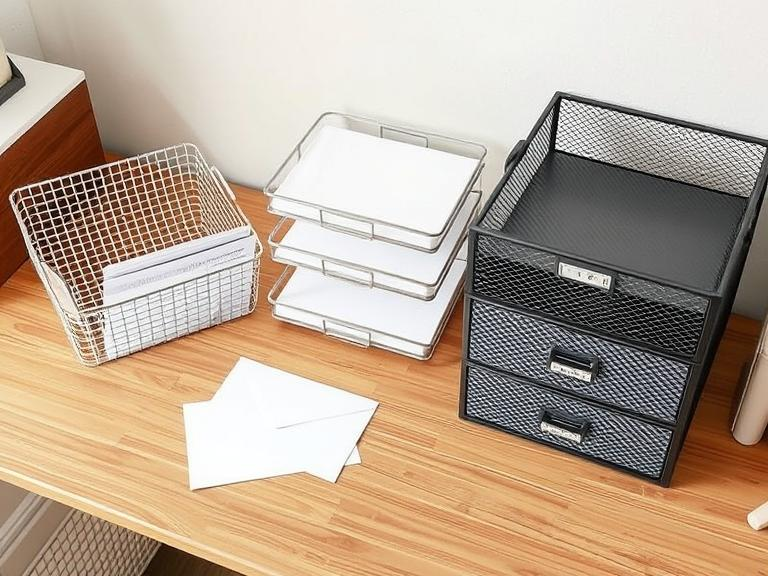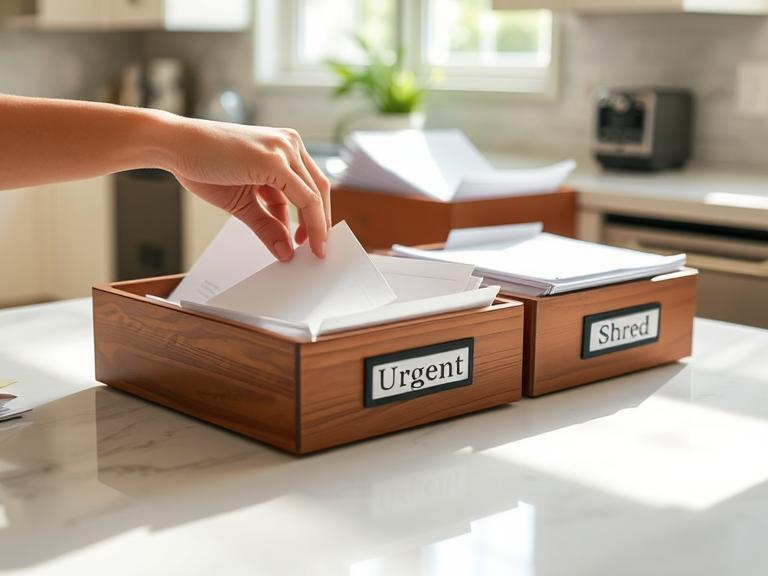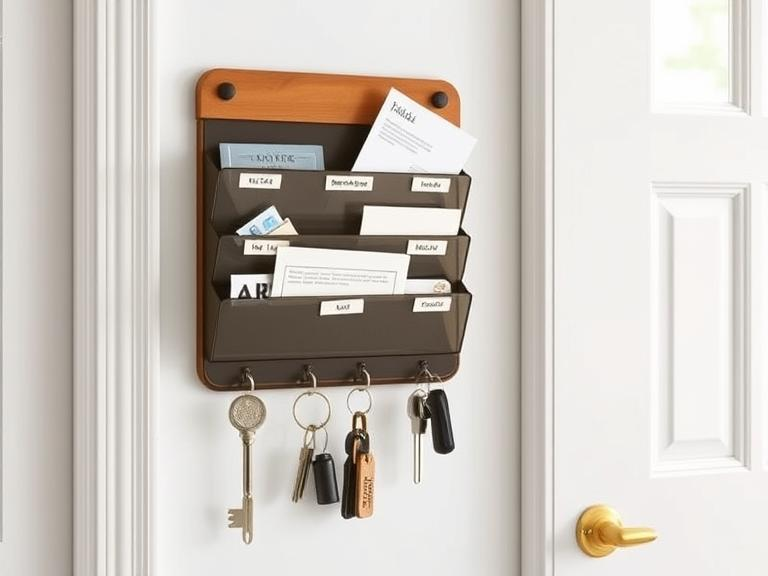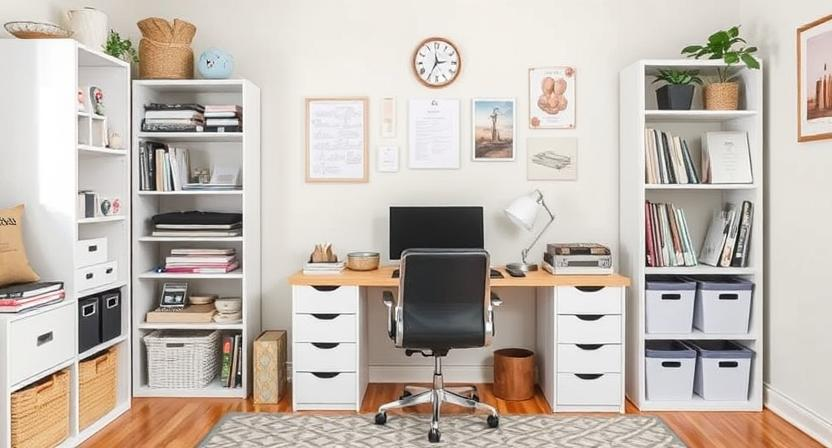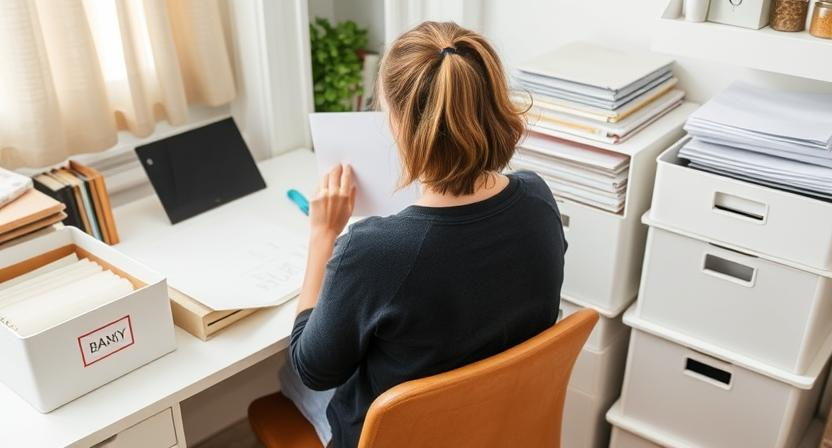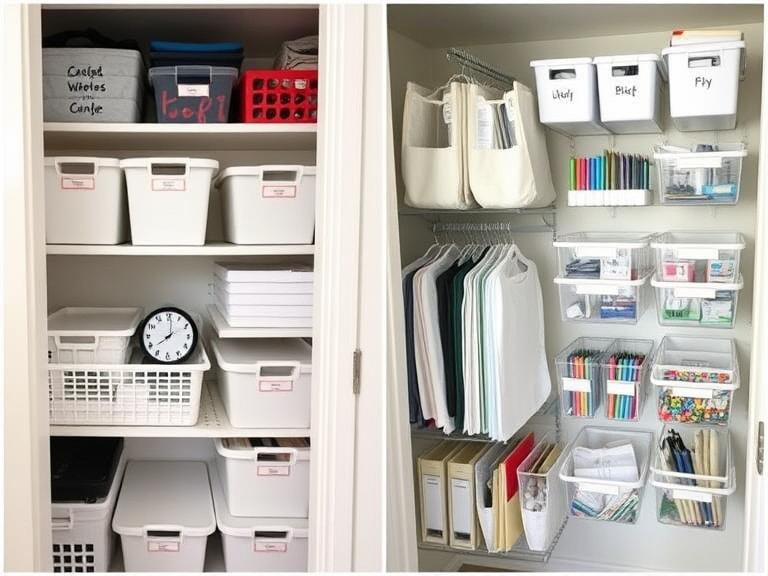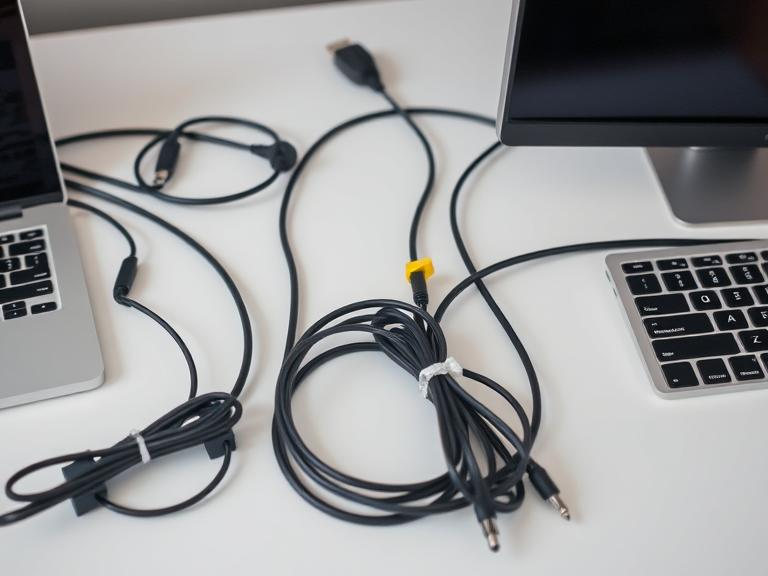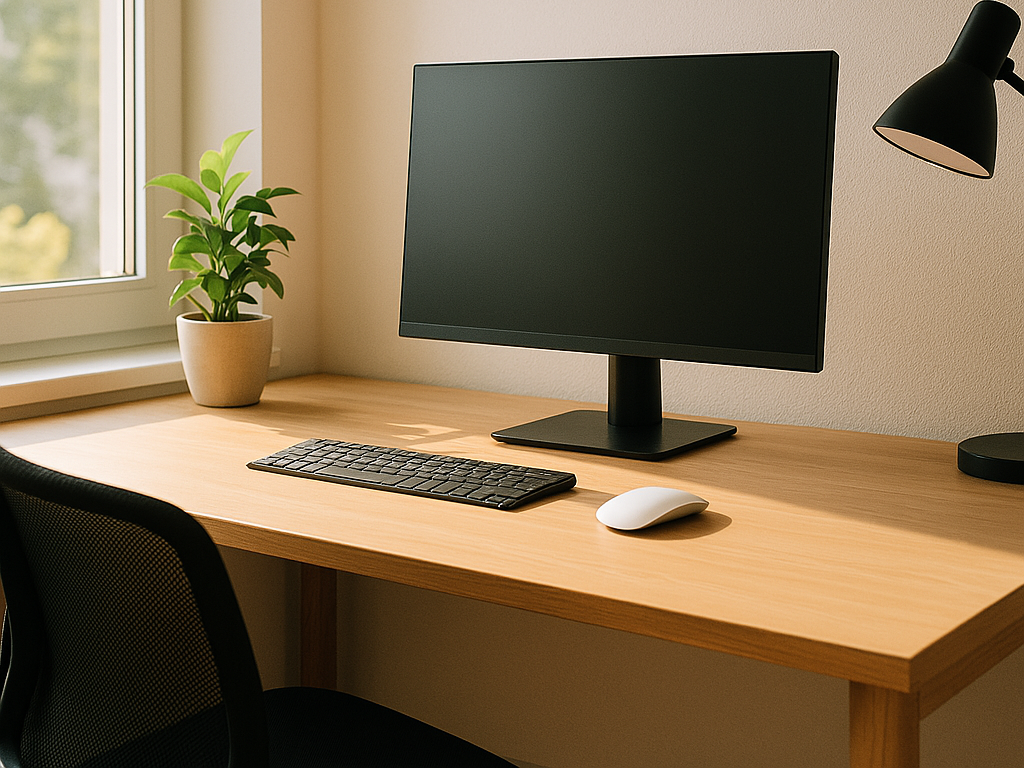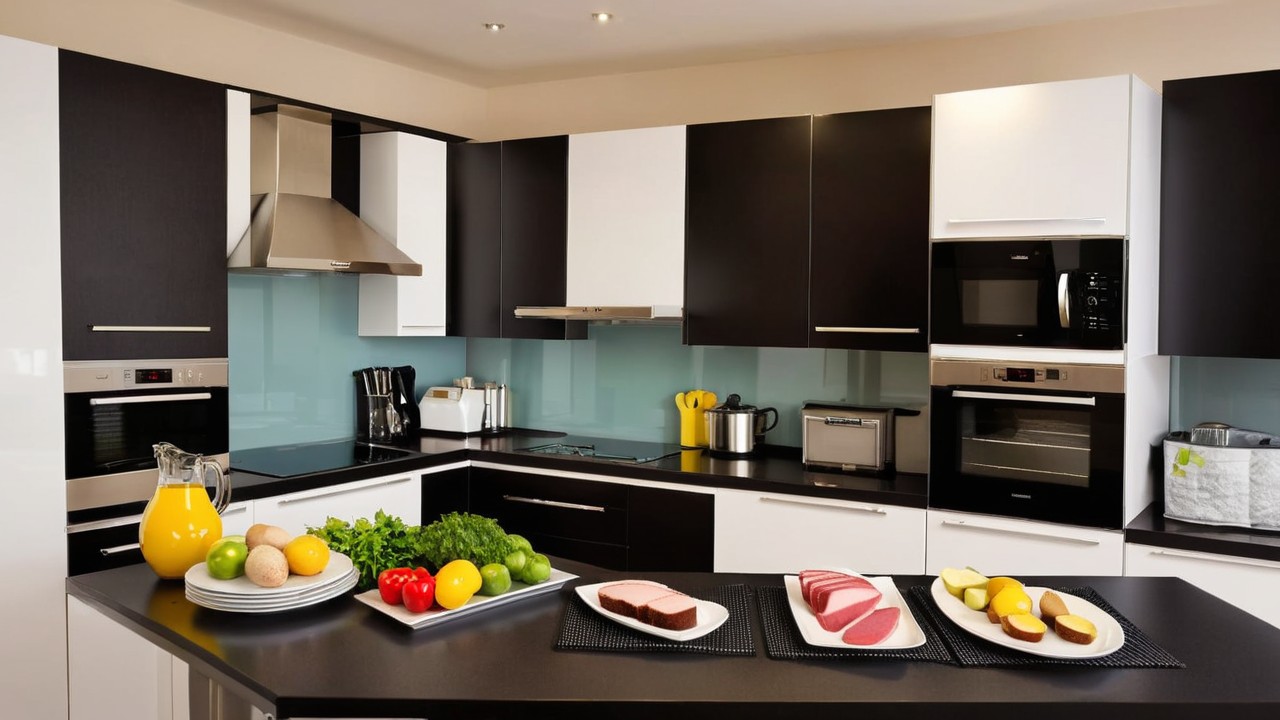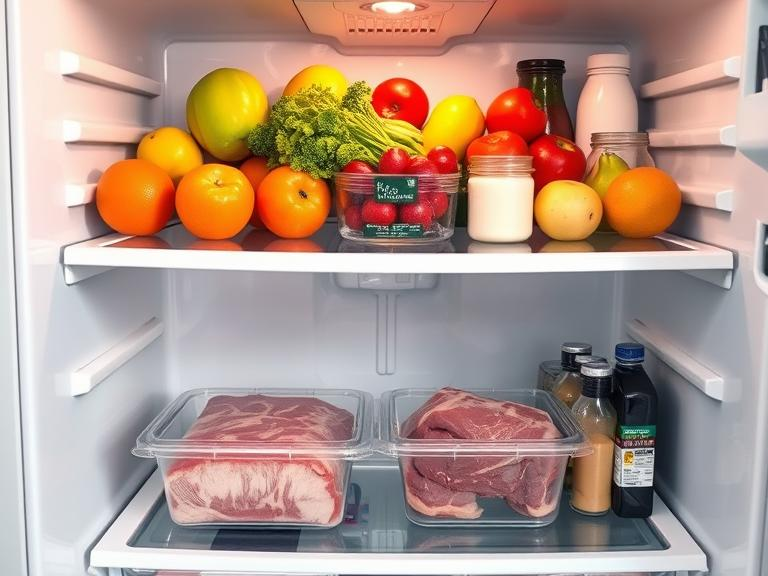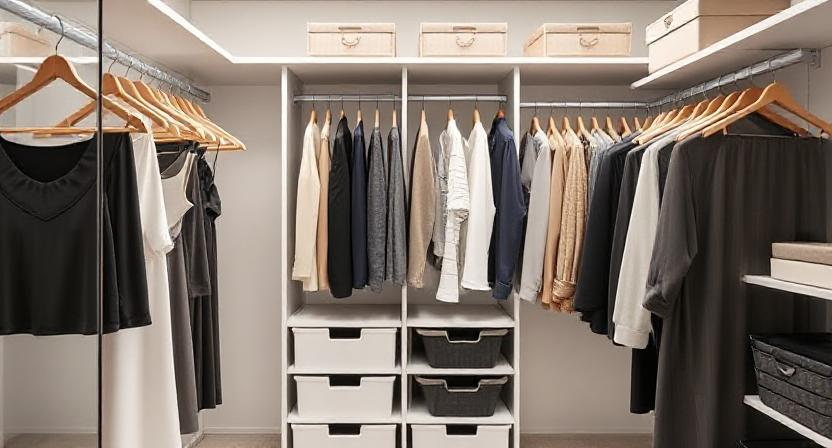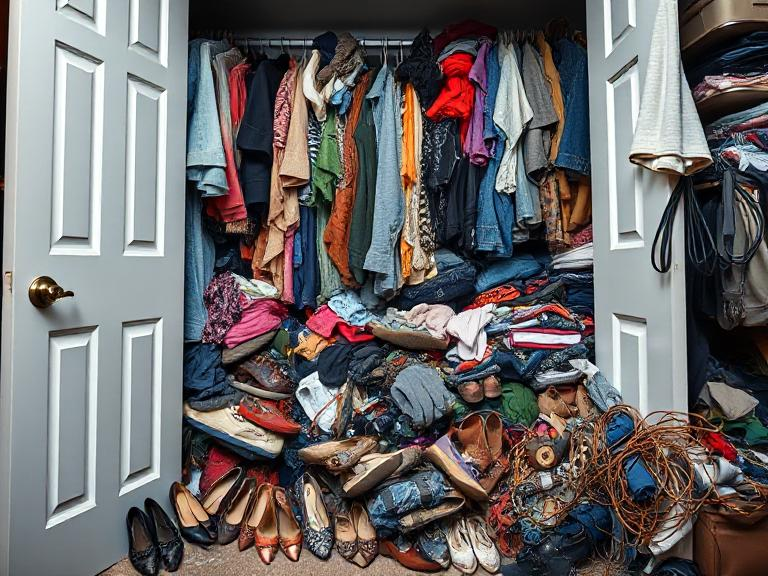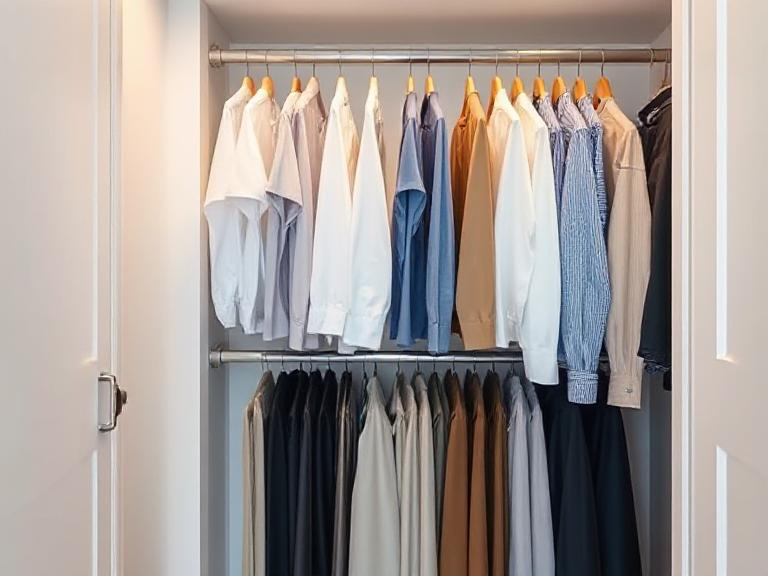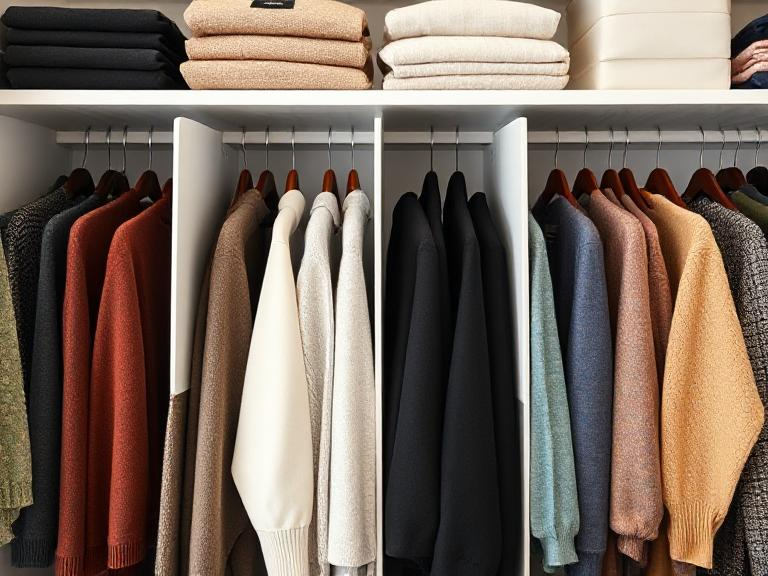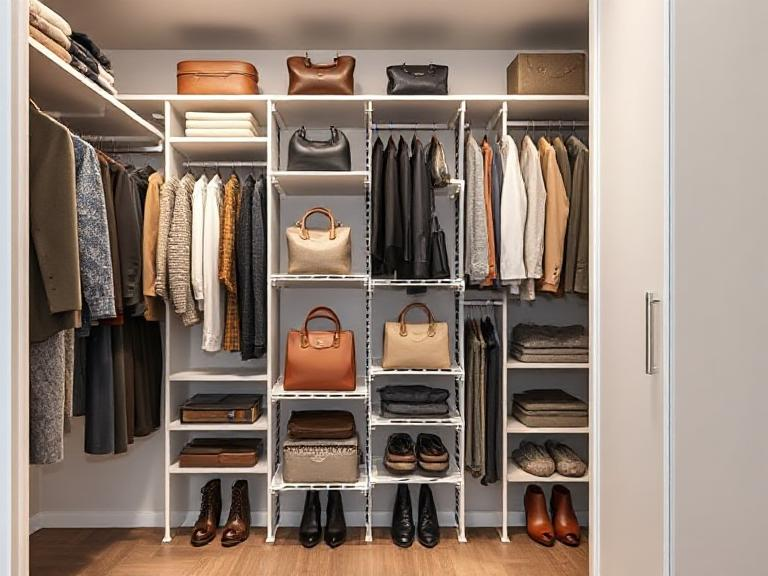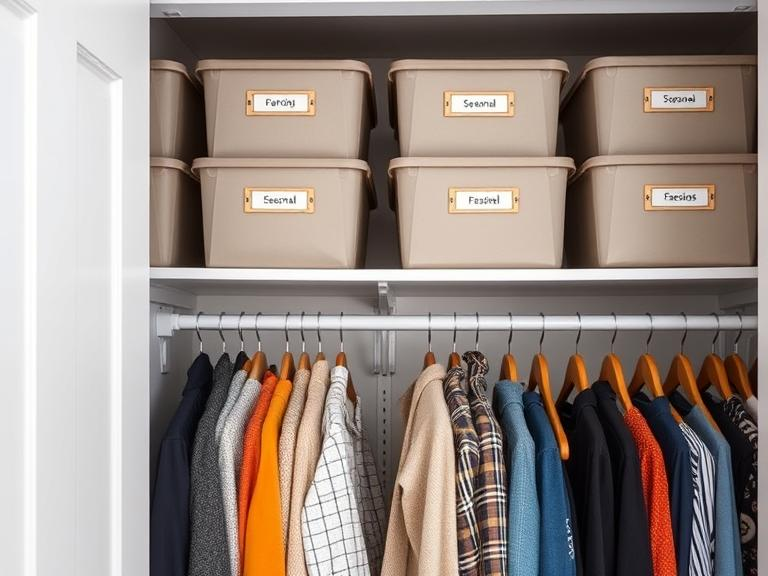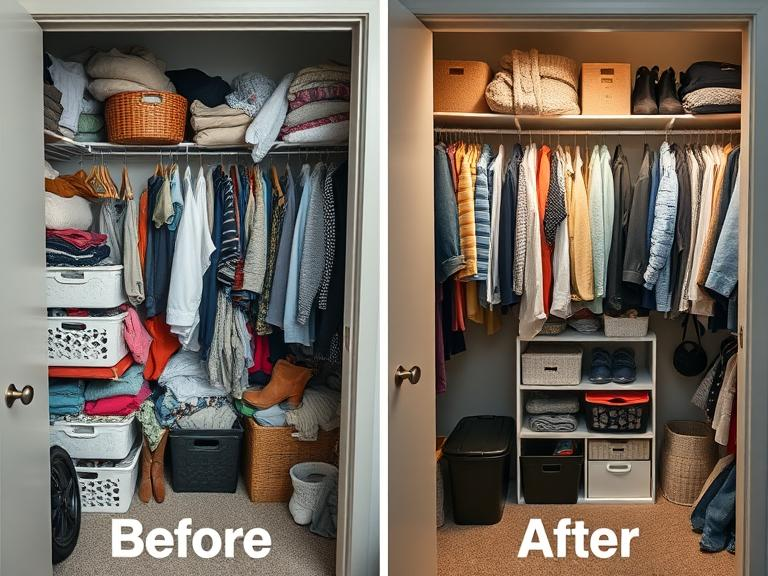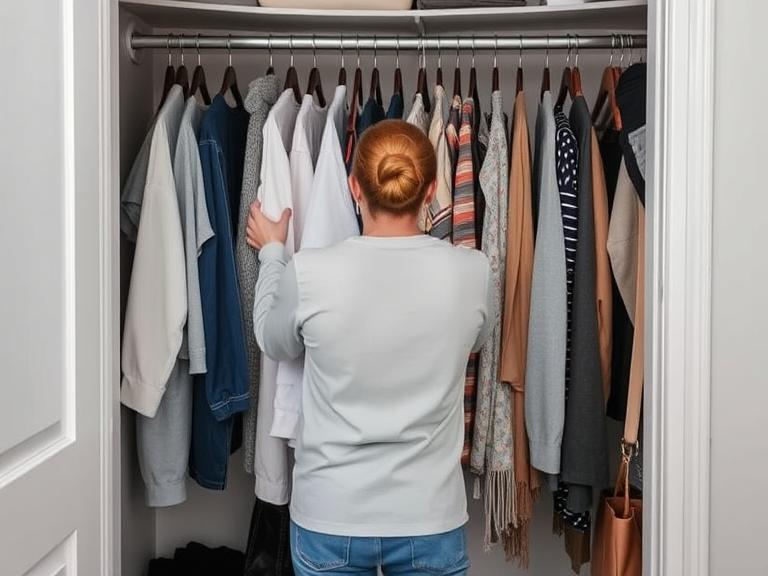![budget home office organization ideas, A neatly organized home office with a budget-friendly aesthetic featuring a clutter-free desk and smart storage solutions]()
Working from home is no longer a trend; it’s a lifestyle shift that millions have embraced. Remote work has its perks, but it also brings challenges. You might deal with messy desks, tangled cables, and poor lighting. Plus, there’s always that one drawer filled with mystery items. A messy home office doesn’t look unappealing; it hurts your productivity.
That’s where smart planning comes in. Whether you’re dealing with limited space, tight budgets, or both, this article will walk you through home office organization ideas on a budget that actually work. You can optimize your workspace with smart desk accessories. Also, use closet organization ideas to transform hidden areas. These practical tips help you reclaim your office without spending too much.
We’ll look at budget, mid-range, and premium products. These picks aim to enhance your focus and comfort. By the end, you’ll have the tools, and motivation, to create a home office that fuels your day instead of draining it.
Messy Home Office Nearly Cost My Cousin a Client
Before we get into organizing your home office, let me tell you a quick story.
Aliya, my cousin, is a talented freelance designer who loves her craft. But her home office? Total chaos. Papers were piled high, cables were tangled beneath her desk, and her office closet was more of a black hole than a storage space. She insisted she “knew where everything was,” but when a client urgently needed a file, panic set in.
It took her 20 minutes of frantic searching before she finally found it, buried under a stack of old notebooks. The delay nearly cost her the project. That moment was her wake-up call. She spent the weekend decluttering, repurposing storage bins, and taming the cable mess. Now, her office is calm, her workflow is much smoother, and she never has to scramble for a lost file again.
If your workspace feels anything like Aliya’s used to, don’t wait for a crisis, fix it now. Let’s dive in and get your home office organized!
Assess Your Space: The First Step to a Better Work Environment
Before you dive into organizing, take a moment to examine your workspace thoroughly. Check your current setup first. This is important for a smart change, especially if you want to save money. It’s not just about buying new things. It’s about improving what you already own to match your needs better.
Start with these focus points:
1. Desk Setup
Is your desk cluttered or too small for your daily tasks? Maybe your monitor takes up too much space, or your keyboard doesn’t sit at a comfortable height. A simple monitor riser or repositioning can make a huge difference.
2. Lighting
Poor lighting kills productivity. Is natural light available? Can you reposition your desk to take advantage of it? If not, even a budget-friendly LED lamp with adjustable brightness can change your work vibe.
3. Storage & Accessibility
Are you constantly reaching, digging, or searching? Identify items you use daily and place them within arm’s reach. Use vertical space, like wall-mounted shelves or pegboards, for things you don’t use as often.
Aligning your workspace with your workflow isn’t a luxury; it’s a strategy. And with clever home office organization ideas on a budget, it’s totally doable.
Declutter: Letting Go of What You Don’t Need
Clutter doesn’t take up space; it drains your mental energy. If your workspace is overrun with paper piles, unused tech, or visual distractions, it’s time to clear it out. One of the smartest home office organization ideas on a budget is simply learning what to let go of. You don’t need a shopping spree; you need a strategy.
Here’s how to declutter effectively:
1. Purge Paper Piles
Go through every stack of paper. Share what’s outdated, file what’s important, and scan documents you might need digitally. Apps like CamScanner and Adobe Scan can help you get rid of paper clutter. They make your files easy to access.
2. Toss Outdated Gadgets and Supplies
That old printer you haven’t used in two years? Recycle it. Extra chargers, dried-out pens, and broken headphones take up space but do nothing useful. Donate or discard responsibly.
3. Clear off your desk surface
A clutter-free desk boosts focus. Keep only what you use daily: a laptop, notepad, pen, and maybe one motivational item. Everything else can go in drawers, bins, or on shelves.
To keep your space clean, establish these simple weekly habits:
- Set aside 15 minutes each Friday for a quick reset. Dispose of trash, return misplaced items, and wipe down surfaces for a fresh start to the weekend.
- Digital Declutter Day encourages you to organize your digital space weekly. Clean up your files. Delete old downloads and empty your recycle bin. This will help you have a neater and more efficient digital space.
- Inbox Zero Check-In Keep your email organized and avoid clutter. Set up rules and folders to sort incoming messages. This helps keep your inbox tidy and makes managing your correspondence easier.
Build good habits and stay open to change. This way, your workspace can feel light, organized, and under control. Best of all? These home office organization ideas on a budget won’t cost you a cent.
Storage Strategies: Home Office Closet Organization Ideas That Work
When it comes to home office closet organization ideas, making the most of your closet space can revolutionize your workspace. Closets in a home office often go unused. But with some creativity, they can hold files, printers, and office supplies perfectly.
Here’s how to transform your closet into an efficient and functional part of your office:
1. Use vertical space with shelves.
Add shelves at different heights. This way, you can store office supplies, books, and binders. Adjustable shelves can grow with your needs, accommodating larger items or small trinkets. You can even store things like extra paper, ink cartridges, or office décor here to keep them out of sight.
2. Incorporate bins for organization.
Bins are essential for organizing smaller items like pens, cords, and notepads. Clear plastic bins or fabric boxes with labels help to keep everything in its place. Label everything clearly. This way, you can quickly find what you need without digging through it all.
3. Set Up a Printer Zone
A closet works well for your printer. It keeps it hidden but still easy to reach. If your closet is deep enough, add a small table or a pull-out shelf to hold the printer. This helps you keep your workspace tidy. You can still reach your office essentials quickly.
4. Turn unused closet space into a mini workspace.
If you have a closet with ample room, why not transform it into a small nook for deep work? Add a compact desk and an ergonomic chair. This creates a private space to focus without distractions. With clever organization, you can also store extra files and supplies nearby.
These home office closet organization ideas are practical, affordable, and can help you make the most of every square inch in your home office. You can store files, hide your printer, or set up a space for focused work. The options are endless.
Tame the Tangle: How to Organize Cables for Storage
When it comes to how to organize cables for storage, tangled cords can quickly become a nightmare, cluttering your workspace and creating unnecessary stress. Organize your charging cables, data cables, and even the seldom-used ones. Use practical solutions to keep them neat and easy to access.
Here are a few effective methods for managing your cables:
1. Cable Clips and Ties
Use adhesive cable clips to hold cords along the edge of your desk or wall. For cables you need close at hand, tie them with reusable Velcro ties. This keeps cords from falling to the floor and ensures you can easily grab them when needed.
2. Cable Sleeves
To keep many cables together and avoid tangling, use cable sleeves. These flexible tubes hold several cords together. They keep cords neat and stop them from tangling.
3. Cable Boxes for Bulk Storage
For rarely used cables, store them in a cable management box. You can find options with separate compartments. These keep charging cables and data cables organized. This cuts down on mess.
4. Labeling Cables
One of the most important steps in how to organize cables for storage is labeling. Use small stickers or tags to mark charging cables and data cables. This prevents confusion and saves time when you need to find the right cord.
By following these instructions on how to organize cables for storage strategies, you’ll keep your cords organized, accessible, and tangle-free!
Workspace Essentials: Product Recommendations for Every Budget
Transform your workspace with the right essentials, no matter your budget. From budget-friendly organizers to premium standing desks, here are some home office organization ideas on a budget that will help improve both the functionality and style of your workspace.
- Declutter Your Desk Easily: This steel mesh organizer has several compartments for pens, paper clips, sticky notes, and more office supplies. It keeps your workspace tidy and efficient. You can quickly grab items without digging through piles.
- Durable and Stylish: This organizer features a sleek black finish and strong steel construction. It lasts long and fits well with any workspace décor. It’s the perfect mix of durability and aesthetics.
- No More Sliding Chaos: Rubber pads on the organizer’s bottom stop it from sliding. This keeps everything in place. This design keeps your desk safe from scratches. It combines function and style.
- Eye-Friendly Lighting: The soft, flicker-free LED light helps reduce eye strain. This is important for long work or study sessions. The lamp provides balanced light that won’t leave you feeling fatigued even after hours of use.
- Adjustable Brightness: Pick from 18 lighting options for any time or task. Whether you need bright, focused light or a softer ambiance, you can adjust it to your preference.
- Compact and Functional: This foldable design saves desk space and includes a USB charging port. This makes it easier to charge your devices. You won’t need extra cables cluttering your workspace.
- Quick and Easy Setup: The Vari Electric Standing Desk has a pre-installed frame and slide-and-lock legs. You can set up your desk in under 10 minutes. No complicated tools are required, and it’s ready for work in no time.
- Sturdy and Durable: This desk features strong steel legs and a thick, solid table top for dependable support. It can handle the weight of several monitors, gear, and other work items.
- Easy Height Adjustment: This desk has four height settings you can program. You can quickly switch between sitting and standing. The smooth electric motor makes transitions easy. It helps improve your posture and keeps you comfortable all day long.
If you want to declutter, boost your lighting, or get ergonomic solutions, these products will enhance your workspace!
Design for Focus: Color, Layout, and Ergonomic Hacks
Creating a workspace that fosters focus is essential, and incorporating home office organization ideas on a budget can make a big impact on your productivity and comfort.
1. Color Psychology for Productivity
Colors influence mood and focus. Soft blues and greens can calm the mind, while yellows and oranges spark creativity. Choose a color palette that aligns with the type of work you do to boost energy and focus.
2. Best Layouts for Limited vs. Open Spaces
In small areas, choose a simple layout. A corner desk works well to save space. For bigger spaces, set up zones. Have one area for work and another for relaxation. This helps keep your mind clear.
3. Affordable Ergonomic Upgrades
Small changes, like an adjustable chair or laptop stand, can help your posture. A mouse pad with wrist support or a footrest helps reduce strain. This way, you stay comfortable during long hours at your desk.
You can turn your workspace into a productivity hub by combining these elements, all without spending too much!
Lighting the Right Way: Natural vs. Artificial Solutions
Natural light is key to boosting mood and energy. Exposure to daylight helps regulate your circadian rhythm, improving focus and reducing fatigue. Studies show that working in natural light can enhance cognitive performance and mood.
Place your desk near windows for an energy boost. Just avoid direct sunlight to prevent glare. If your space has no windows, use full-spectrum light bulbs. They mimic natural daylight and can boost your mood and energy all day.
1. Choosing and Placing Desk Lamps
Selecting the right desk lamp is crucial for effective task lighting. Choose adjustable lamps with customizable brightness. They light up your workspace well and reduce harsh shadows and eye strain. Position your desk lamp so that it lights your workspace directly, especially for reading, writing, or detailed tasks.
Ensure the lamp doesn’t cast glare on your computer screen. Lamps with a dimming feature let you adjust the light. This helps you find the right brightness for your task, making it more comfortable and boosting your productivity.
2. Avoiding Screen Glare and Eye Strain
Preventing screen glare is crucial for maintaining comfort during long work sessions. To cut glare, position your desk so it faces the windows. This keeps direct light off your screen. Anti-glare screen protectors or matte-finish monitors can also help reduce reflections.
Additionally, position your monitor so the top of the screen is at or slightly below eye level. This encourages a more natural viewing angle, reducing strain on your eyes. Take regular breaks using the 20-20-20 rule. Every 20 minutes, look at something 20 feet away for 20 seconds. This helps reduce eye strain.
Weekly Routines to Maintain Your Space
Staying organized and maintaining a tidy workspace doesn’t need hours of effort, just a few simple habits each week:
- Quick Desk Cleanup: Set aside 10-15 minutes once a week to wipe down surfaces, dust your desk, and organize scattered items. A clean desk promotes focus and reduces stress.
- Sort Papers Regularly: Keep your workspace clutter-free by sorting through paperwork weekly. File essential documents and toss anything unnecessary to avoid paper piles.
- Tidy Cords and Cables: Cables can quickly become a mess. Use cable organizers or clips to keep cords in place and prevent tangling. This keeps your desk looking neat and reduces the risk of tripping over cords.
Adding Personal Touches Without Adding Clutter
While personal items enhance creativity, too many can disrupt your workspace. Here’s how to strike a balance:
- Choose Meaningful Items: Personalize your desk with a few meaningful items that inspire you, such as a photo, a favorite book, or a small plant. But remember, less is more. Too many items can make the space feel crowded.
- Multi-Functional Decor: Opt for decor that has a function. A stylish storage box can store office supplies while adding a touch of personality. A beautiful calendar can help you stay organized while enhancing the aesthetics.
Seasonal Refreshes: When to Reorganize or Redecorate
Changing things up periodically gives your space a fresh look and keeps your motivation high:
- Rearrange for New Energy: Changing the layout of your desk or workspace can give you a new perspective. Try different setups to see what works best for your workflow.
- Seasonal Updates: With each season, bring in small updates that align with the time of year. For example, switch out heavy blankets for lighter ones in spring, or add cozy decor during the winter months. Small seasonal touches can create a refreshing atmosphere without overwhelming the space.
Final Thoughts: Build a Space You Want to Show Up To
Creating an inspiring, functional workspace doesn’t require a hefty budget. Start by using home office organization ideas on a budget to declutter, organize, and make thoughtful investments in key items like desk organizers, task lighting, and ergonomic upgrades. These simple changes can turn your space into a productivity hub, and they won’t cost much.
When considering home office closet organization ideas, think about utilizing every inch of available space for storage. Keep things organized and accessible with shelves, bins, and labels. Also, consider how to organize cables for storage effectively using cable clips or boxes to avoid tangles and keep your desk clean. A great workspace isn’t a luxury; it’s a mindset. Create a space you want to show up to every day, and enjoy the benefits of increased focus and comfort.at tangled mess of cables. You’ve got this.


